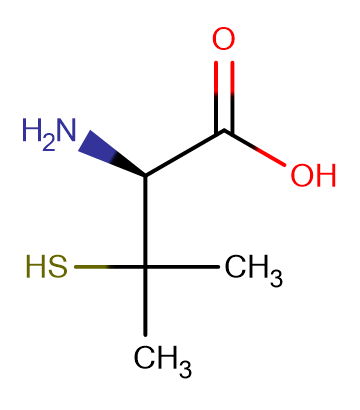
D-(-)-Penicillamine
CAS No. 52-67-5
D-(-)-Penicillamine( NSC 81549 | D-Penicillamine | β-Thiovaline )
Catalog No. M14865 CAS No. 52-67-5
(2S)-2-Amino-3-methyl-3-sulfanylbutanoic acid is the most characteristic degradation product of the penicillin antibiotics.
Purity : >98% (HPLC)
 COA
COA
 Datasheet
Datasheet
 HNMR
HNMR
 HPLC
HPLC
 MSDS
MSDS
 Handing Instructions
Handing Instructions
| Size | Price / USD | Stock | Quantity |
| 10MG | 49 | In Stock |


|
| 25MG | 74 | In Stock |


|
| 50MG | 90 | In Stock |


|
| 100MG | Get Quote | In Stock |


|
| 200MG | Get Quote | In Stock |


|
| 500MG | Get Quote | In Stock |


|
| 1G | Get Quote | In Stock |


|
Biological Information
-
Product NameD-(-)-Penicillamine
-
NoteResearch use only, not for human use.
-
Brief Description(2S)-2-Amino-3-methyl-3-sulfanylbutanoic acid is the most characteristic degradation product of the penicillin antibiotics.
-
Description(2S)-2-Amino-3-methyl-3-sulfanylbutanoic acid is the most characteristic degradation product of the penicillin antibiotics. It is used as an antirheumatic and as a chelating agent in Wilson's disease. Target: Others (2S)-2-Amino-3-methyl-3-sulfanylbutanoic acid (Cuprimine, Depen) is used as an antirheumatic and as a chelating agent in Wilson's disease and is a chelating agent recommended for the removal of excess copper in patients with Wilson's disease. From in vitro studies which indicate that one atom of copper combines with two molecules of penicillamine. (In Vitro):Penicillamine (D-(-)-Penicillamine) (5 mg; 7 d; CD4+ and CD+ splenocytes) promotes cellular immune responses.(In Vivo):Penicillamine (D-(-)-Penicillamine) (200 mg/kg; i.g.; daily, for 3, 10 and 14 d; tx mice and DL mice) increases serum free copper concentration.Penicillamine (200 mg/kg; i.g.; daily, for 3, 10 and 14 d; tx mice and DL mice) increases ATP7A and CTR1 mRNA expression in the brain of tx mice.Penicillamine (200 mg/kg; i.g.; daily, for 3, 10 and 14 d; tx mice and DL mice) induces oxidative-stress in the central nervous system.Penicillamine (0.1-250 mg/kg; i.p.; once, for 90 min; male NMRI mice) has binaural phase effect on seizure.Penicillamine (5 mg/kg; i.v.; daily, for 8 weeks; male BN rats) prevents the onset of autoimmunity at a low dose.
-
In VitroPenicillamine (D-(-)-Penicillamine) (5 mg; 7 d; CD4+ and CD+ splenocytes) promotes cellular immune responses. Western Blot Analysis Cell Line:CD4+ and CD+ splenocytes Concentration:5 mg Incubation Time:7 days Result:Increased IL-4 and IFN-γ mRNA expression in response to high dose treatment and remained high in both CD4+ and CD+ splenocytes.
-
In VivoPenicillamine (D-(-)-Penicillamine) (200 mg/kg; i.g.; daily, for 3, 10 and 14 d; tx mice and DL mice) increases serum free copper concentration.Penicillamine (200 mg/kg; i.g.; daily, for 3, 10 and 14 d; tx mice and DL mice) increases ATP7A and CTR1 mRNA expression in the brain of tx mice.Penicillamine (200 mg/kg; i.g.; daily, for 3, 10 and 14 d; tx mice and DL mice) induces oxidative-stress in the central nervous system.Penicillamine (0.1-250 mg/kg; i.p.; once, for 90 min; male NMRI mice) has binaural phase effect on seizure.Penicillamine (5 mg/kg; i.v.; daily, for 8 weeks; male BN rats) prevents the onset of autoimmunity at a low dose. Animal Model:Toxic milk mutant mice (tx mice) and DL mice Dosage:200 mg/kg Administration:Oral gavage; daily, for 3, 10 and 14 days Result:Increased the free copper concentrations in the tx mice serum on the 3rd day.Animal Model:Toxic milk mutant mice (tx mice) and DL mice Dosage:200 mg/kg Administration:Oral gavage; daily, for 3, 10 and 14 days Result:Increased the mRNA expression of ATP7A by 4-fold. Increased CTR1 mRNA expression by 6.9-fold in the cortex and 9.1-fold in the basal ganglia of tx mice.Animal Model:Toxic milk mutant mice (tx mice) and DL mice Dosage:200 mg/kg Administration:Oral gavage; daily, for 3, 10 and 14 daysResult:Increased the concentration of MDA and decreased GSH/GSSG ratios through nitric oxide/NMDA pathways.Animal Model:Male NMRI miceDosage:0.1, 0.5, 1, 10, 100, 150 and 250 mg/kg Administration:Intraperitoneal injection; once, for 90 minutesResult:Had anticonvulsant effects at a low dose (0.5 mg/kg) and had anticonvulsant effects at a high dose (250 mg/kg). Reversed the anti- and proconvulsant effects by acute pretreatment of L-NAME (a nonselective nitric oxide synthase inhibitor) and 7-NI (a selective neuronal nitric oxide synthase inhibitor).Animal Model:Male BN rats Dosage:5 mg/kg Administration:Intravenous injection; daily, for 8 weeks Result:Inhibited IgE upregulation and prevented the onset of autoimmunity.
-
SynonymsNSC 81549 | D-Penicillamine | β-Thiovaline
-
PathwayOthers
-
TargetOther Targets
-
RecptorCopper
-
Research AreaInflammation/Immunology
-
Indication——
Chemical Information
-
CAS Number52-67-5
-
Formula Weight149.21
-
Molecular FormulaC5H11NO2S
-
Purity>98% (HPLC)
-
SolubilityWater: 30 mg/mL (201.05 mM)
-
SMILESCC(C)([C@H](C(=O)O)N)S
-
Chemical Name(2S)-2-amino-3-methyl-3-sulfanylbutanoic acid
Shipping & Storage Information
-
Storage(-20℃)
-
ShippingWith Ice Pack
-
Stability≥ 2 years
Reference
1. Brewer GJ. Expert Opin PharmacOthers. 2006 Feb;7(3):317-24.
molnova catalog



related products
-
DiD perchlorate
DiD perchlorate is a lipophilic cyanine dye that can be used in cells tracking.
-
Methyl pentadecanoat...
Methyl pentadecanoate is a natural product.Methyl pentadecanoate is a saturated fatty acid methyl ester obtained from the esterification of myristic acid. Methyl myristate shows a high melanin induction in B16F10 melanoma.
-
XP-59
XP-59 is a potent inhibitor of the SARS-CoV Mpro, with a Ki of 0.1 μM.



 Cart
Cart
 sales@molnova.com
sales@molnova.com


